
Do you follow proper Snake Plant care steps? This guide provides the answers to water needs, light and temperature requirements, humidity, propagation, fertilizing, repotting, soil, and the most common diseases and pests.
| Botanical Name (Latin Name/Scientific Name): | Sansevieria Trifasciata |
| Common Name: | Snake plant |
| Light: | low light tolerant (50+ lux = 5 foot candles); prefers full sunlight (40,000+ lux = 4,000 foot candles); |
| Watering: | once the soil has fully dried out |
| Soil: | succulent or cacti mix |
| Repotting: | once a year |
| Temperature: | 65°F (18°C) to 75°F (23 – 24°C) |
| Humidity: | 5% to 24%, but it adapts well to lower humidity |
| Toxicity for Pets: | Yes (diarrhea, vomiting, nausea) |
| Toxicity for Humans: | Yes (vomiting or diarrhea, skin irritation) |
| Propagation: |
|
| Pruning: | Prune dead or diseased growth |
Light Requirements
| Minimal amount of light: | 50 Lux (5 FC) |
| Optimal amount of light: | full sun: 40,000+ lux (4,000+ FC) |
| Direct sun tolerance: | 8+ hours |
| Category: | low light tolerant |
Sanseviaria trifasciata prefers full sun (direct sun for most of the day), with light levels over 80,000 lux (8,000 FC). But as long as you can provide light over 5,000 lux (500 foot candles), it will be happy.
In commercial nurseries, Sansevieria plants are grown in open fields where they get full sun, ranging from 80,000-140,000 lux of light (8,000-14,000 foot candles). Then they are moved to greenhouses where they are acclimated to 10,000-60,000 lux (1,000 – 6,000 foot candles). The reason for these high light levels is that the nurseries are trying to produce plants as fast as possible, and with more light, they get bigger nicer-looking growth, and plants reach the adult stage faster. Light is plant food. More light equals more photosynthesis. These levels of light were confirmed by R.W. Henley, A.R. Chase and L.S. Osborne from the University of Florida Institute of Food and Agricultural Sciences, in their Sansevieria Production Guide.
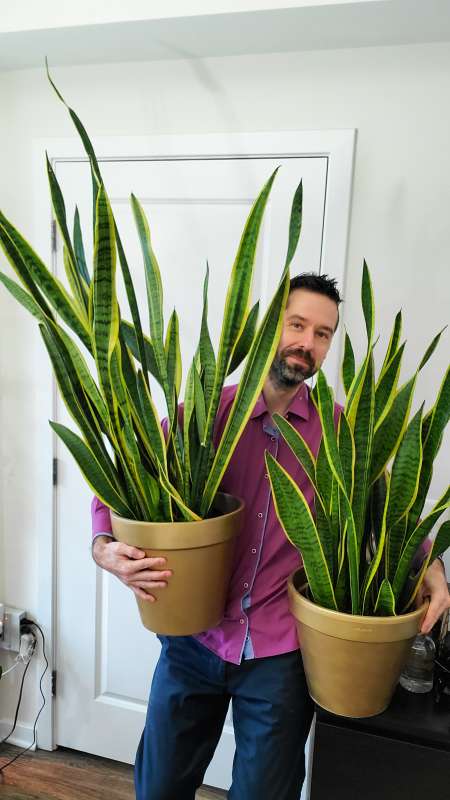
Mr. Houseplant and his Snake plants
It is true that it’s a low-light TOLERANT plant but it’s very important to emphasize that it’s not a low-light LOVING plant. There are no low-light loving plants :) Only low-light tolerant. You could put it in a dark corner and it will stay alive and look relatively well for months, maybe even years, depending on the amount of light.
But…
Will it be happy? No.
Will it grow fast? No. ⠀
After enough time spent in low light, plant’s leaves will become elongated and droopy, like in the following image:
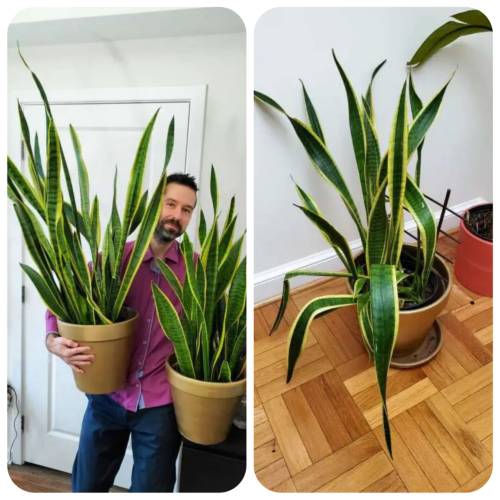
Snake plant grown in bright light (left) vs. grown in low light (right, notice the droopy leaves)
Your Snake Plant will grow healthier, and produce more shoots if it’s getting bright light over 3,000 lux (300 foot candles), ideally at least 5,000 lux (500 foot candles) and a few hours of direct sun (over 40,000 lux = 4,000 foot candles).
Like with any sun loving plant, make sure to gradually acclimate it to direct sun, otherwise it may get sunburns.
Can my Sansevieria tolerate really low light?
Yes, it can tolerate really low light for a while, but it will not thrive in it. After a while the leaves will become long and droopy, and it will not have the same nice, compact look as when you got it. Make sure to move your Sansevieria to a brighter spot in your home as soon as you get a chance.
Water Needs
Water your Snake Plant once the soil has fully dried out. Make sure the soil is completely dry before watering, all the way to the bottom of the pot. To be on the safe side, you can wait an additional week or two (or even more) before watering again. With snake plants it’s always better to go on the side of underwatering. They are drought-tolerant and could survive even a few months without water, in the situation of lower light.
But you don’t want to do that unless you really have to (i.e. you’re travelling) as at some point the roots will start dying out if they don’t get water.
Plant it in very porous soil, which doesn’t retain a lot of water and dries out quickly, so you know it’s safe to water it every two weeks or more often. But if you are new to plants, don’t stick to a certain watering schedule; make sure to always check the soil before deciding whether to water.
How can I tell if I am underwatering my Sansevieria?
Wrinkling and curling leaves may be a sign that you’re underwatering your Sansevieria plant. If your Snake Plant is in a terracotta pot, in a well-draining soil mix, and is getting bright light, the soil will dry out faster and the plant will need more frequent watering.
If your plant has really been underwatered for a long time, some of the leaves will start to turn yellow and die.
How Can I Tell If I Am Overwatering My Sansevieria?
If your Sansevieria leaves are mushy and soft and start showing signs of rot, the most likely reason is overwatering. Soft spots on leaves could also be a sign of bacterial disease, but in this case, mushines will be restrained to a small part of the leaf. Make sure to always check the soil before you water your Snake Plant. Water only when the soil is fully dry. If you encounter a bacterial infection, cut off the affected leaf and discard it.
Humidity Needs
Snake Plant doesn’t require high humidity to thrive. In general, low humidity levels of 5% to 24% are enough but even if it gets higher levels of humidity, it will still do just fine.
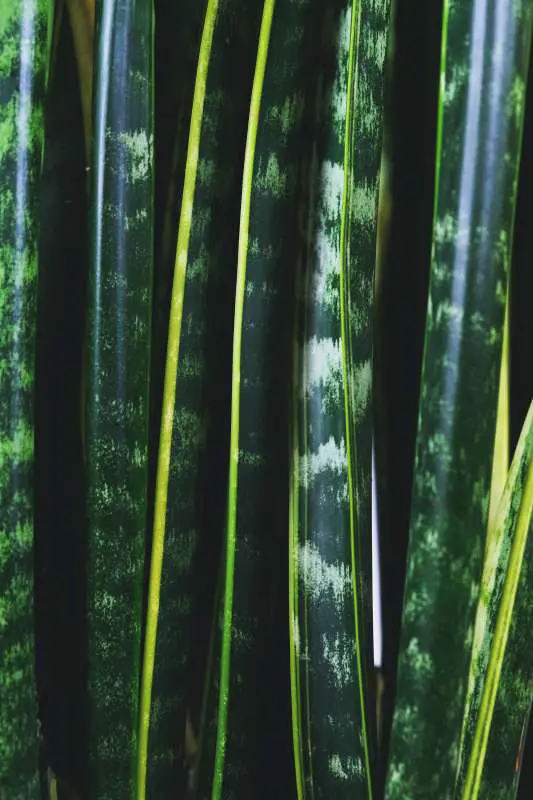
Close-up shot of a Sansevieria laurentii
Temperature Requirements
Sansevieria Plant likes an average temperature between 65°F (18°C) and 75°F (23 – 24°C) to grow actively and stay healthy. Higher temperatures will also be fine.
Fertilizing
If you repot your Snake Plant annually, there won’t be a need to fertilize it, as all nutrients the plant needs will be replenished with fresh soil. If you, however, don’t want or cannot repot regularly, I recommend Espoma Succulent and Cactus Fertilizer. Feed your Sansevieria every two to four weeks in periods when it enjoys lots of light and is actively growing. Make sure to always follow instructions on the packaging for frequency and concentration of the fertilizer.
Soil
Snake Plants are succulents, so when potting them, I combine 25% perlite and 25% bark with 50% of any commercial potting mix, like Proven Winners potting soil. Most commercially sold potting mixes do not have enough macropores for oxygen, so you need to amend them.
Another option is to combine perlite, bark, and vermiculite to make about 50% of the mix. Sometimes I also use pumice. If you find it easier, you can also use this succulent and cacti soil.
Repotting
When repotting Snake Plants, I like to use terracotta pots so the soil can dry out faster. When making a potting soil mix, I make sure I use a lot of perlite to provide the plant with more oxygen and make the soil less water-retaining. I usually combine 1 part perlite and 1 part bark with 2 parts of any commercial potting mix, or I combine perlite, bark, and vermiculite to make about half of the mix. Sometimes I also use pumice.
Here is how I repotted my whale fin snake plant:
And a video of sansevieria cylindrica repotting:
Toxicity To Humans
Snake plants are toxic to humans and ingesting them can cause mouth and throat irritation, vomiting or diarrhea. Getting plant sap on the skin can cause skin rash and irritation. The following research and expert guidance illustrate these points:
Mouth and throat irritation, vomiting. Research from July 2019 by Prof. Hayk S. Arakelyan, Doctor of Medical Sciences from Tokyo Medical University Hospital confirms that the symptoms are often mild in humans and include mouth and throat irritation, nausea and vomiting.
Skin rash and irritation. Ann King Filmer, Ph.D. Plant Scientist from the University of California, in the publication “Safe and Poisonous Garden Plants” from October 2012 confirms that the sap of Sansevieria can cause a skin rash or irritation.
Toxicity To Pets
According to the American Society For The Prevention Of Cruelty To Animals (ASPCA) Snake Plants are toxic to your pet. If you notice symptoms such as nausea, vomiting, or diarrhea, your pet has probably ingested this plant.
Pruning
You can prune your Snake Plant if it has dead (dry or brown) leaves or if it’s infected. However, if the plant is healthy, there is no need to prune it.
Propagation
You can use water or soil to propagate your Snake Plant.
Sansevieria Plant Water Propagation
You can cut one leaf into several pieces; the larger the cuttings, the faster they will propagate. Once the cuttings grow new shoots, you can pull off the new shoots and leave the cuttings in water to grow another set of shoots. Make sure to keep the water at room temperature to speed up the propagation process and replace water weekly or more often, as soon as it gets dirty, to replenish oxygen and restore PH value.
Light and warmth are the factors that contribute to the speed of propagation. I use a heat mat and I place the cuttings in a spot where they can get several hours of direct sun and a lot of bright indirect light (well over 3,000 lux = 300 foot candles).⠀
⠀
Without a heat mat, it usually takes me about two months to get some roots on a Snake Plant cutting. A heat mat can increase the soil/water temperature by 5 to 10 degrees, and in doing so, speeds up propagation.⠀
⠀
Another thing you could do to promote propagation speed is to add an air pump, just like the ones you would use in an aquarium. Air pumps provide oxygen which is also very important for roots, as they take in oxygen and release carbon dioxide.
Sansevieria Plant Soil Propagation
Take the leaf from the mother plant and cut it into several sections. Let the leaf cutting ends dry out a little bit for a few days. After a few days, the wounds will heal and the cuttings will be ready to put them in soil.
Now make a potting mix of soil and sand or perlite, stick the cuttings into the soil, and water. Preferably, use a terracotta pot. Place the pot onto the heat mat and provide lots of light.
I used sand to improve the drainage of the soil. While you can find sand of different sizes, it’s better to use medium to coarse sand (0.25 – 2mm), as it provides better drainage. The problem is it’s very heavy, so you can’t use a lot of it, and you can’t use it in large pots, as they become very difficult to lift. Instead of sand, you could use perlite.⠀⠀
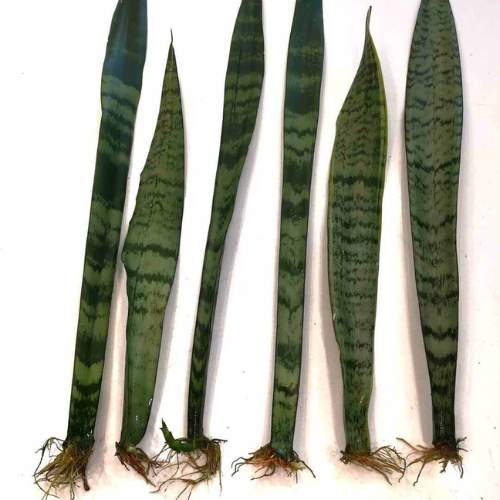
Sansevieria plant cuttings
How Long Does It Take To Propagate a Snake Plant?
Snake plants propagate very slowly. It will usually take 1-2 months for the cuttings to start growing roots (if the conditions aren’t optimal, even longer). And getting new shoots can take from 2 months to even several months. If you provide a lot of light and warmth to the cutting, you can speed up this process.
Pests
Snake Plants are susceptible to spider mites, mealybugs, and thrips which attack the leaves, sucking the sap out of them. To combat pests, spray the plant thoroughly with a mixture of 5 drops of neem oil, 5 drops of dish soap, and 16oz of water. Neem oil disrupts insects’ feeding which causes them to die quickly.In case of a thrips infestation, besides treating with neem oil, also remove the old soil and wash the roots, as some species of thrips have a resting stage in the soil. To combat mealy bugs spray the plant with a solution of 1 part rubbing alcohol and 7 parts water.
Take a look at the following videos for tips on how to get rid of snake plant pests:
Diseases
The most common diseases that can affect Snake Plants are:
- Soft rot (Erwinia carotovora)
- Red leaf spot (Fusarium moniliforme)
- Southern blight (Sclerotium rolfsii)
Soft rot (Erwinia carotovora)
Soft rot is a bacterial problem present in propagation that is characterized by mushy rot of the bottom part of the cutting, accompanied sometimes by a rotten and fishy smell which is typical for Erwinia infection. Soft and mushy rot is another symptom and you will notice it on the lower end of a cutting. The best option to reduce chances of soft rot is to sterilize pruning tools when you take cuttings.
Red leaf spot (Fusarium moniliforme)
Red leaf spot is a fungal disease and usually appears on the newest leaves as irregularly shaped reddish brown lesions, sometimes with a yellow border. If the leaves are wet, the chances of red leaf spot increase. Lesions have an irregular shape and happen when there are spores and the whorl is wet. They have yellow borders and the color is reddish-brown. To prevent red leaf spot on your Snake plant, keep the leaves dry. To treat the red leaf spot, apply a fungicide.
Southern blight (Sclerotium rolfsii)
Southern blight symptoms are displayed as water-soaked necrotic lessionslesions on the leaves. Prune all disease parts of the plant and make sure to sterilize pruning tools before and after pruning.
Bacterial infection on a snake plant. The spot will be soft and ooze liquid.
Common Problems
Yellowing leaves
Yellowing leaves on your Sansevieria can be caused by several factors many different factors, but the most common are – overwatering, underwatering, bacterial disease and pest damage. If the leaves are soft and mushy, the culprit is overwatering. Repot the plant in new, fresh soil, and cut off all soft and mushy roots. Make sure you’re watering once the soil has fully dried out, but that you’re not leaving your plant without water for weeks at a time.
Also inspect the plant closely for pests and any soft spots that could be caused by a bacterial infection. Treat for pest infestations with neem oil and cut off any parts with a bacterial infection.
Curling Leaves
Curling leaves on your Sansevieria can be caused by a number of reasons — from underwatering to pest infestation. Make sure your Sansevieria receives enough light, you don’t overwater it, the soil is right, it’s not too cold or hot, to be able to diagnose it and find the cause for its leaves curling. You can also schedule a virtual one-on-one consultation with me and we can do it together.
FAQs about Snake Plant
How fast does a Snake Plant grow?
Snake Plant is generally a very slow grower. The way snake plant grows is that it only puts out new growth once a year. Even though in the meantime it might seem it’s not doing anything, it is accumulating energy for producing new growth. If it’s kept in low or medium light, it will not get a lot of energy, and will not produce a lot of new leaves. The new growth might also be spindly. The more light you give it, the more leaves it will produce when it starts growing and they will be better looking and sturdier.
How long does a Snake Plant live?
With good care, Snake Plants can live several decades.
Are Snake Plants easy to care for?
Snake Plants are famous for being the easiest indoor plants to take care of, perfect for beginners. The reason for that is their tolerance to low light and the fact they can go for long periods without watering.
Is Sansevieria Trifasciata The Same As Whale Fin Snake Plant?
No, Sansevieria Masoniana is not the same as Whale Fin snake plant. The scientific name of the Whale Fin snake plant is Sansevieria Masoniana. If you want to learn more about Whale Fin snake plant care, check out the detailed blog post on the topic.
How to get a Snake Plant to bloom?
First, a snake plant needs to be mature enough to be able to bloom. If you’ve just started a plant from a cutting, do not expect it to bloom soon. Also, Snake Plants need a lot of energy to produce flowers and they get this energy from sunlight. If you want your Snake Plant to bloom, give it as much light as possible, some direct sun as well.
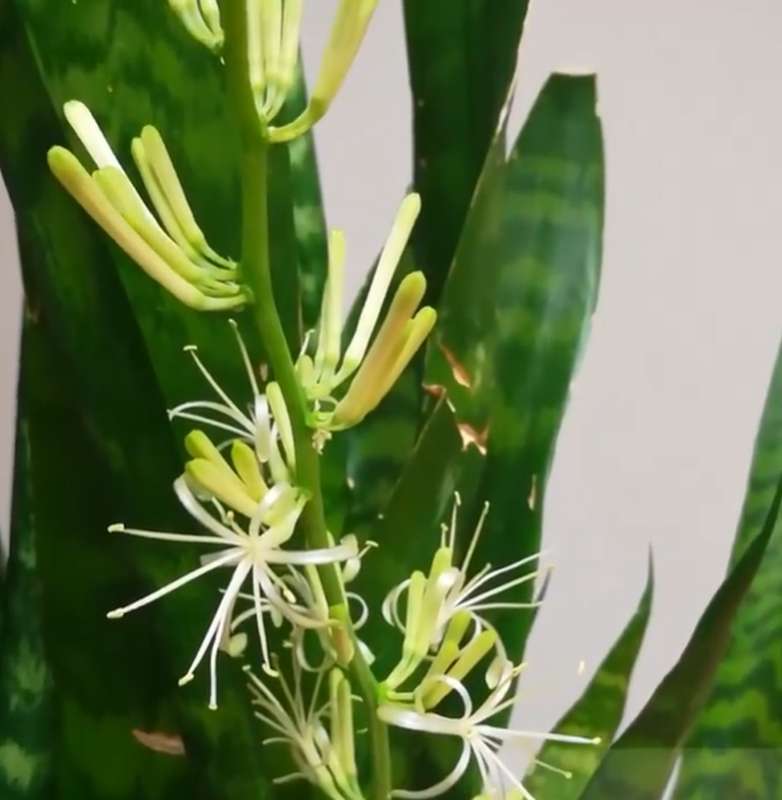
Snake Plant Flowering
What is Sansevieria Trifasciata Black Dragon?
Sansevieria Trifasciata Black Dragon is a snake plant with dark green leaves. It is a common name for Sansevieria Trifasciata ‘Future Midnight’. Plants grown through leaf propagation of Sansevieria Trifasciata ‘Sheri’ are also called Sansevieria Trifasciata Black Dragon.
Have More Questions about Snake Plant Care?
If you’re having doubts or more questions regarding Snake Plant care, please let me know in the comments below this article. You can also schedule a virtual one-on-one consultation with me and get the help you need.
Always happy to help!
Yours Truly,


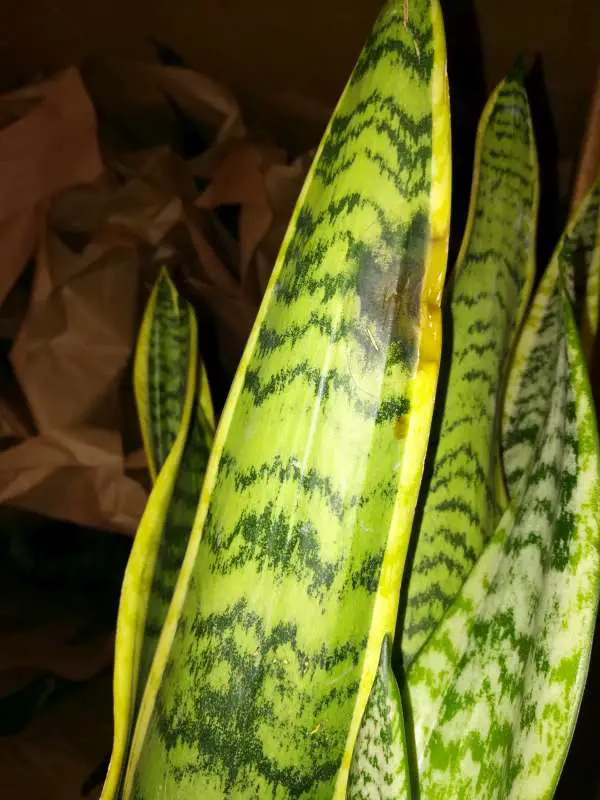
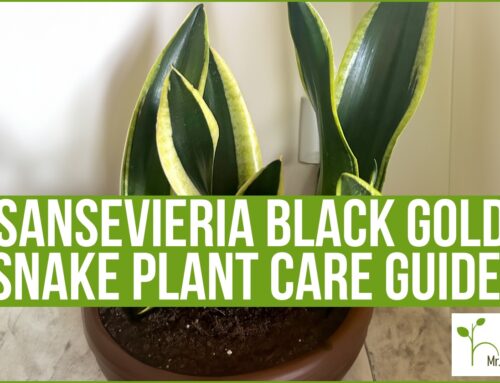
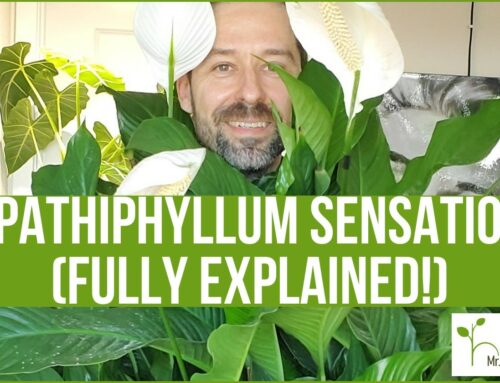



After dividing and reporting my snake plant into many smaller plants they have grown very nicely EXCEPT the variegated coloring of the leaves is gone. My leaves are all solid green. Why? I love the variegated coloration.
Hi Gail, variegated snake plant will lose its variegation if it’s propagated from individual leaves, without a piece of the rhizome. Is it possible that something like that happened? If not, you can send me a photo on Instagram or Facebook.
I was told it’s good to have a pot in the bedroom.
Hi, you can keep a plant in the bedroom depending on how much light it will be getting and whether you want to keep it in good shape long term. If your bedroom doesn’t get a lot of light you can expect your plant to become droopy after a few months 🙂